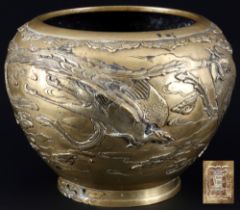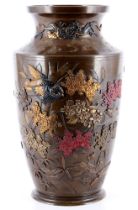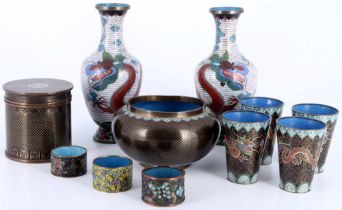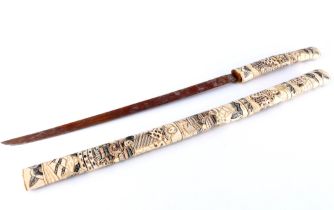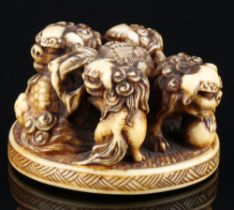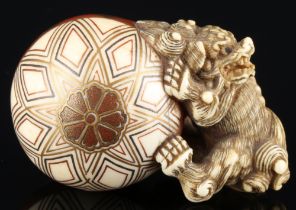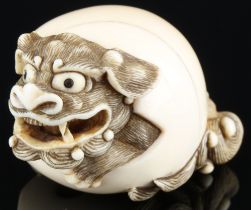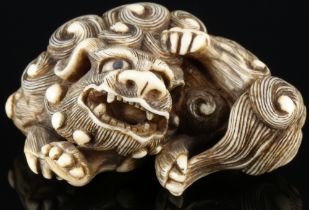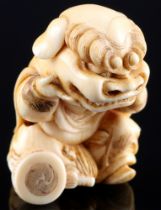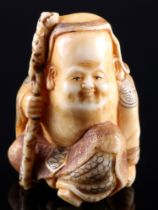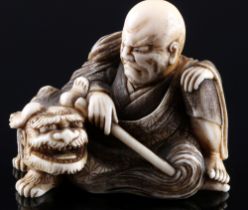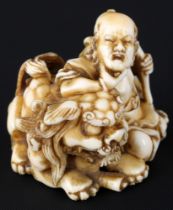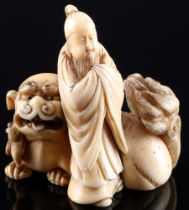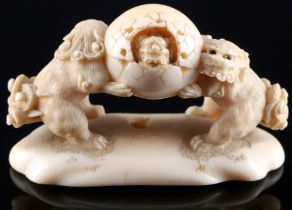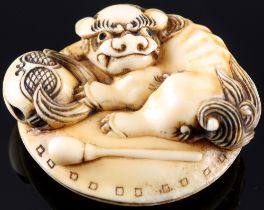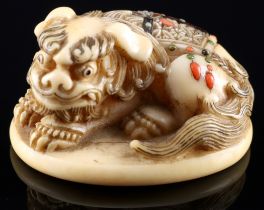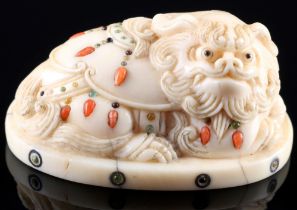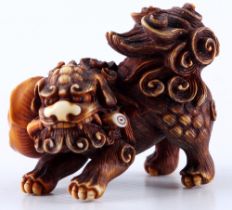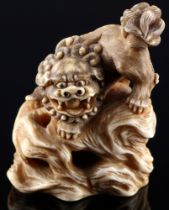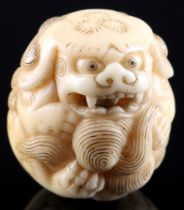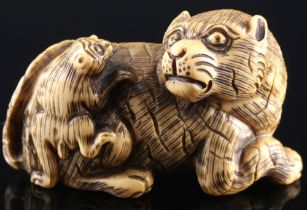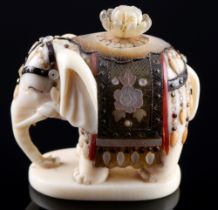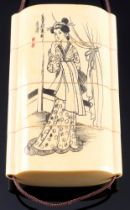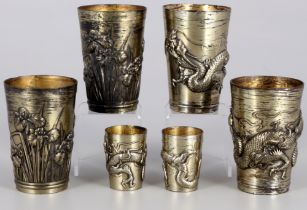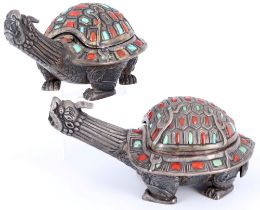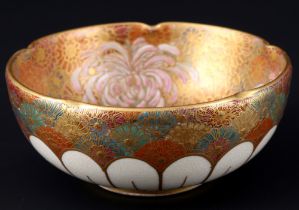Perfeziona la tua ricerca
Filtered by:
- Creator / Brand
- Elenco
- Grid
A subscription to the Price Guide is required to view results for auctions ten days or older. Click here for more information
Bronze incense burner, Japan, Meiji period 1868-1912, engraved three phoenixes, flowing clouds, floor mark Japan Kyoto, made by Yoschida, H 21.5 c...
Bronze, Japan Meiji period 1868-1912, large vase with birds and floral decoration partly in red, gold, black and green, above two embracing dragon...
Bronze / cloisonne, Meiji period 1868-1912, a total of 11 objects of which 4 colorful dragon cups, H 8 cm, 2 vases, H 19.5 cm, water bowl with Ruy...
Bone carved with steel blade, Japan, Meiji period 1868-1912, detailed carving with various character scenes, L 74 cm x W 3.5 cm, blade with rust, ...
Japan Meiji period 1868 to 1912, hippopotamus, the netsuke represents a shishi quartet playing with balls. Expressive and very finely carved, pati...
Japan Meiji period 1868 to 1912, ivory, the netsuke depicts a shishi playing with a ball. The ball is decorated with fine patterns, painted with l...
Japan, Meiji period 1868 to 1912, ivory, the netsuke represents a shishi caught in a ball, H 28 mm x W 42 mm x D 28 mm, weight 25.43 grams, Proven...
Japan Meiji period 1868 to 1912, hippopotamus, the netsuke represents a shishi, lying on its stomach, scratching its left ear, H 22 mm x W 47 mm x...
Japan 19th/20th Century, ivory Katabori-Netsuke boy with shishi mask, signed, Meiji period,
Japan Meiji period 1868 to 1912, ivory, the netsuke depicts a boy with a shishi mask, expressively crafted, the signature cannot be clearly assign...
Japan Meiji period 1868 to 1912, hippopotamus, the netsuke represents a god of luck, Fukurokuju with stick. Sitting, resting contentedly within hi...
Japan Meiji period 1868 to 1912, hippopotamus, the netsuke represents a man with a shishi, sitting nestled together. The clothing is designed in d...
Japan 19th/20th Century, ivory Katabori-Netsuke man with shishi, Shungetsu, signed, Meiji period,
Japan Meiji period 1868 to 1912, ivory, the netsuke depicts a man with shishi, expressively crafted. The man has a stick in his hand and looks gri...
Japan Meiji period 1868 to 1912, ivory, the netsuke depicts a man with a shishi, expressively crafted. The man has a stick in his hand and looks g...
Japan Meiji period 1868 to 1912, ivory, the netsuke depicts a man with a shishi. The man standing with his back leaning against the shishi. Filigr...
Japan Meiji period 1868 to 1912, ivory, the netsuke depicts three shishis, two playing with a ball in which a small shishi sits. The eyes are inla...
Japan Meiji period 1868 to 1912, ivory, the netsuke depicts a playing shishi, lying on a plate, with a temple bell and mallet. A brush is carved o...
Japan Meiji period 1868 to 1912, the netsuke represents a shishi lying on a base plate. A small blanket covers the shishi. This blanket has decora...
Japan Meiji period 1868 to 1912, ivory, the netsuke represents a shishi, lying on a base plate. A small blanket covers the shishi. Small stones ar...
Japan Meiji period 1868 to 1912, hippopotamus, the netsuke represents a shishi, standing with a flower in its mouth, signed Harukazu on the bottom...
Japan Meiji period 1868 to 1912, hippopotamus, the netsuke represents a shishi, standing on a rock, with a ball in its mouth, the parallel lines, ...
Japan Meiji period 1868 to 1912, ivory, the netsuke represents a shishi, sitting, huddled into a ball. Very expressively crafted, H 31 mm x W 28 m...
Japan Meiji period 1868 to 1912, ivory, the netsuke depicts a tiger with cubs, lying down, the cubs climbing up the mother. Very expressively craf...
Japan Meiji period 1868 to 1912, ivory, the netsuke depicts an elephant, from the Shibayama school. Various materials were used for inlays, e.g. m...
Japan Meiji period 1868 to 1912, ivory, the inro is four parts, the surface is decorated with incised drawings. A geisha is depicted on the front ...
Shibuichi, Japan Meiji period 1868-1912, with master's mark on the back, bowl depicting a samurai warrior on horseback, further island, bird and d...
Japan 6 cups Meiji period 19th century,
Japan, Meiji period 1868-1912, 6 metal cups, four of which are engraved with flying dragons and two with lotus flowers, 4 x H 8.8 cm x D 5.8 cm, 2...
Silver, Japan Meiji period 1868-1912, not stamped but tested, 2 large silver turtles with inlaid turquoise and red coral. L 16.5 cm x W 10.5 cm x ...
Porcelain, Meiji period 1868-1912, fine and detailed painting with chrysanthemums and golden threads, H 4 cm x D 9 cm

